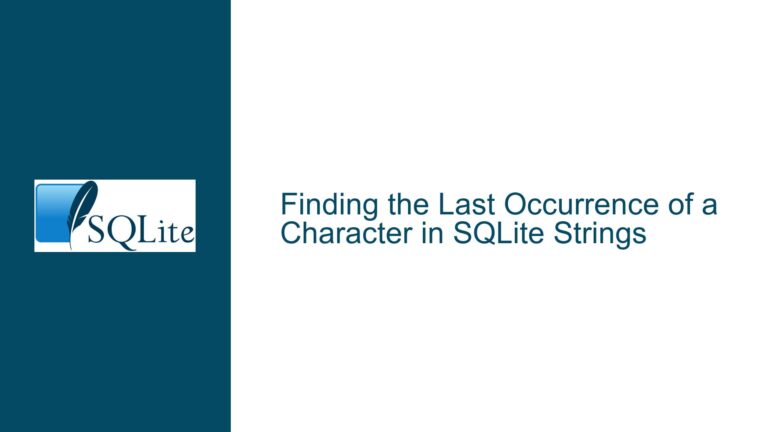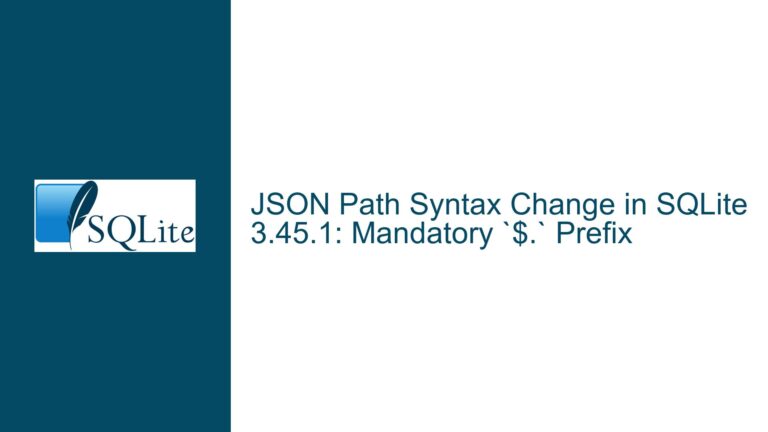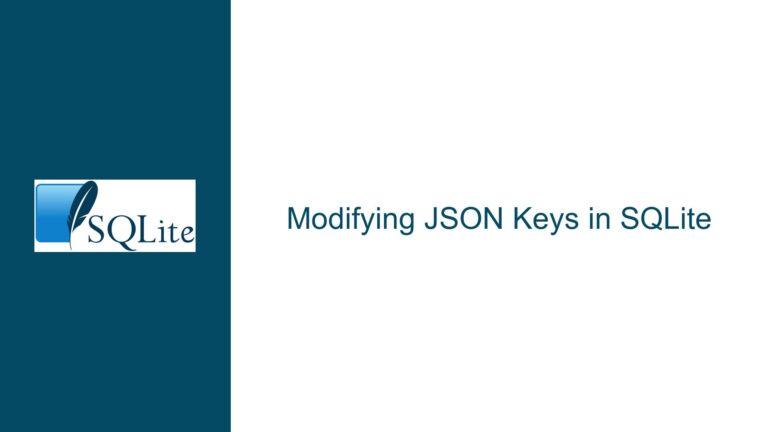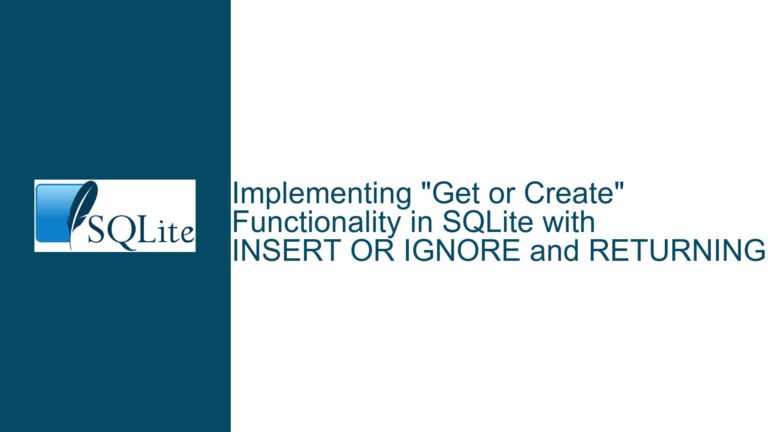DATETIME Division by Float in SQLite: Troubleshooting and Solutions
Understanding the DATETIME and Float Division Problem
When working with SQLite, one of the most common issues that developers encounter is the inability to directly perform arithmetic operations on DATETIME fields. This is particularly evident when attempting to divide a DATETIME value by a floating-point number. The core of the problem lies in how SQLite handles DATETIME values internally. Unlike some other databases, SQLite does not have a dedicated DATETIME data type. Instead, DATETIME values are typically stored as text strings in a specific format, such as "HH:MM:SS". This text-based representation means that SQLite does not inherently recognize these values as numeric quantities, making direct arithmetic operations impossible.
The issue becomes apparent when you attempt to execute a query like SELECT Zeit_gelaufen / km_gelaufen FROM laufdaten1, where Zeit_gelaufen is a DATETIME field and km_gelaufen is a numeric field. SQLite will not interpret the DATETIME value as a number, leading to an error or unexpected behavior. This is because SQLite treats the DATETIME value as a plain text string, and dividing a string by a number is not a valid operation.
To solve this problem, it is essential to understand the underlying mechanics of how SQLite stores and manipulates DATETIME values. SQLite’s flexibility in handling different data types can be both a strength and a weakness. While it allows for a wide range of data storage options, it also means that developers must be explicit in their data handling to avoid issues like the one described.
The Role of Data Type Conversion in SQLite
The root cause of the DATETIME division issue in SQLite is the lack of implicit type conversion between text-based DATETIME values and numeric types. SQLite is a dynamically typed database, meaning that it does not enforce strict data types on columns. Instead, it uses a system of type affinity, where the type of a value is determined by its content rather than its declaration. This can lead to situations where a column declared as DATETIME is actually stored as text, and SQLite does not automatically convert this text into a numeric value for arithmetic operations.
In the context of the problem at hand, the Zeit_gelaufen field is stored as text, even though it represents a time value. When you attempt to divide this text value by a numeric value like km_gelaufen, SQLite does not know how to interpret the text as a number. This is why the query fails. To perform the division, you need to explicitly convert the DATETIME value into a numeric format that SQLite can understand.
SQLite provides several built-in functions for working with DATETIME values, including unixepoch, which converts a DATETIME string into the number of seconds since the Unix epoch (January 1, 1970). By using this function, you can convert the Zeit_gelaufen value into a numeric format that can be divided by km_gelaufen. After performing the division, you can then convert the result back into a DATETIME format using the TIME function.
Step-by-Step Solution for DATETIME Division by Float
To solve the problem of dividing a DATETIME value by a float in SQLite, you need to follow a series of steps that involve converting the DATETIME value into a numeric format, performing the division, and then converting the result back into a DATETIME format. Here is a detailed breakdown of the process:
Convert the DATETIME Value to Seconds: The first step is to convert the
Zeit_gelaufenvalue from its text-based format into a numeric value representing the number of seconds. This can be done using theunixepochfunction, which converts a DATETIME string into the number of seconds since the Unix epoch. For example, ifZeit_gelaufenis "00:11:14", you can convert it to seconds using the following query:SELECT unixepoch('00:11:14') - unixepoch('00:00:00');This will return the number of seconds represented by "00:11:14".
Perform the Division: Once you have the
Zeit_gelaufenvalue in seconds, you can divide it by thekm_gelaufenvalue. For example, ifkm_gelaufenis 1.7, you can perform the division as follows:SELECT (unixepoch('00:11:14') - unixepoch('00:00:00')) / 1.7;This will return the result of the division in seconds.
Convert the Result Back to DATETIME Format: After performing the division, you need to convert the result back into a DATETIME format. This can be done using the
TIMEfunction, which converts a numeric value representing seconds into a DATETIME string. For example:SELECT TIME((unixepoch('00:11:14') - unixepoch('00:00:00')) / 1.7, 'unixepoch');This will return the result in the format "HH:MM:SS".
Handle Edge Cases: It is important to consider edge cases when working with DATETIME values. For example, if the
Zeit_gelaufenvalue exceeds "23:59:59" or is negative, you may need to adjust your calculations accordingly. SQLite’s DATETIME functions can handle these cases, but you should be aware of the potential issues and test your queries thoroughly.Optimize for Performance: While the above steps provide a functional solution, it is also important to consider the performance implications of these operations. Converting DATETIME values to and from numeric formats can be computationally expensive, especially if you are working with large datasets. To optimize performance, you may want to consider storing the
Zeit_gelaufenvalue in a numeric format (e.g., seconds) from the outset, rather than converting it on the fly.
By following these steps, you can successfully divide a DATETIME value by a float in SQLite. This approach leverages SQLite’s built-in DATETIME functions to convert between text and numeric formats, allowing you to perform the necessary arithmetic operations. While the process may seem complex at first, it becomes straightforward once you understand the underlying mechanics of how SQLite handles DATETIME values.
Best Practices for Working with DATETIME Values in SQLite
To avoid issues like the one described in this post, it is important to follow best practices when working with DATETIME values in SQLite. Here are some key recommendations:
Store DATETIME Values in a Consistent Format: When storing DATETIME values in SQLite, it is important to use a consistent format. The most common format is "YYYY-MM-DD HH:MM:SS", but you can also use other formats as long as they are consistent. This will make it easier to perform operations on these values and avoid issues with type conversion.
Use SQLite’s Built-in DATETIME Functions: SQLite provides a range of built-in functions for working with DATETIME values, including
unixepoch,datetime, andstrftime. These functions can be used to convert between different formats, perform arithmetic operations, and extract specific components of a DATETIME value (e.g., hours, minutes, seconds). By using these functions, you can avoid the need for complex string manipulation and ensure that your queries are both efficient and accurate.Be Explicit About Data Types: While SQLite is dynamically typed, it is still a good practice to be explicit about the data types you are working with. This can help avoid issues with type conversion and ensure that your queries behave as expected. For example, if you are working with a DATETIME value, you should explicitly convert it to a numeric format before performing arithmetic operations.
Test Your Queries Thoroughly: When working with DATETIME values, it is important to test your queries thoroughly to ensure that they behave as expected. This is especially important when dealing with edge cases, such as values that exceed "23:59:59" or are negative. By testing your queries, you can identify and address any issues before they become a problem.
Consider Performance Implications: As mentioned earlier, converting DATETIME values to and from numeric formats can be computationally expensive. To optimize performance, you may want to consider storing DATETIME values in a numeric format (e.g., seconds) from the outset, rather than converting them on the fly. This can help reduce the computational overhead of your queries and improve overall performance.
By following these best practices, you can avoid common issues when working with DATETIME values in SQLite and ensure that your queries are both efficient and accurate. Whether you are performing arithmetic operations, converting between formats, or extracting specific components of a DATETIME value, these recommendations will help you get the most out of SQLite’s DATETIME functions.
Advanced Techniques for DATETIME Manipulation in SQLite
While the basic approach outlined above is sufficient for most use cases, there are some advanced techniques that can be used to further enhance your ability to work with DATETIME values in SQLite. These techniques can be particularly useful when dealing with complex queries or large datasets.
Using Subqueries for Complex Calculations: In some cases, you may need to perform complex calculations involving multiple DATETIME values. For example, you may need to calculate the difference between two DATETIME values and then divide the result by a numeric value. In such cases, you can use subqueries to break down the calculation into smaller, more manageable steps. For example:
SELECT TIME((SELECT unixepoch('00:11:14') - unixepoch('00:00:00')) / 1.7, 'unixepoch');This approach allows you to perform complex calculations in a single query, without the need for multiple steps.
Leveraging Indexes for Performance Optimization: When working with large datasets, it is important to consider the performance implications of your queries. One way to optimize performance is to use indexes on DATETIME columns. By creating an index on a DATETIME column, you can speed up queries that involve filtering or sorting based on DATETIME values. For example:
CREATE INDEX idx_zeit_gelaufen ON laufdaten1(Zeit_gelaufen);This will create an index on the
Zeit_gelaufencolumn, which can improve the performance of queries that involve this column.Using Views for Simplified Querying: If you frequently perform complex calculations involving DATETIME values, you may want to consider using views to simplify your queries. A view is a virtual table that is based on the result of a SELECT query. By creating a view that performs the necessary calculations, you can simplify your queries and make them easier to read and maintain. For example:
CREATE VIEW vw_laufdaten1 AS SELECT Zeit_gelaufen, km_gelaufen, TIME((unixepoch(Zeit_gelaufen) - unixepoch('00:00:00')) / km_gelaufen, 'unixepoch') AS avg_time_per_km FROM laufdaten1;This view will calculate the average time per kilometer for each row in the
laufdaten1table, making it easier to query this information in the future.Handling Time Zones and Daylight Saving Time: When working with DATETIME values, it is important to consider the impact of time zones and daylight saving time. SQLite does not have built-in support for time zones, so you will need to handle these issues manually. One approach is to store all DATETIME values in UTC and convert them to the local time zone as needed. For example:
SELECT datetime(Zeit_gelaufen, 'localtime');This will convert the
Zeit_gelaufenvalue from UTC to the local time zone.Using Triggers for Automated DATETIME Manipulation: In some cases, you may want to automate the manipulation of DATETIME values using triggers. A trigger is a database object that automatically executes a specified action when a certain event occurs (e.g., when a row is inserted or updated). For example, you could create a trigger that automatically converts a DATETIME value to seconds when a row is inserted into the
laufdaten1table:CREATE TRIGGER trg_convert_zeit_gelaufen BEFORE INSERT ON laufdaten1 FOR EACH ROW BEGIN SET NEW.Zeit_gelaufen = unixepoch(NEW.Zeit_gelaufen) - unixepoch('00:00:00'); END;This trigger will automatically convert the
Zeit_gelaufenvalue to seconds when a new row is inserted into thelaufdaten1table.
By using these advanced techniques, you can further enhance your ability to work with DATETIME values in SQLite. Whether you are performing complex calculations, optimizing performance, or automating DATETIME manipulation, these techniques will help you get the most out of SQLite’s DATETIME functions.
Conclusion
Working with DATETIME values in SQLite can be challenging, especially when you need to perform arithmetic operations like division. However, by understanding how SQLite handles DATETIME values and leveraging its built-in functions, you can overcome these challenges and perform the necessary calculations with ease. The key is to be explicit about data types, use SQLite’s DATETIME functions to convert between text and numeric formats, and follow best practices to ensure that your queries are both efficient and accurate.
In this post, we have explored the core issue of dividing a DATETIME value by a float in SQLite, provided a detailed step-by-step solution, and discussed best practices and advanced techniques for working with DATETIME values. By following these guidelines, you can avoid common pitfalls and ensure that your SQLite queries involving DATETIME values are both effective and efficient. Whether you are a beginner or an experienced SQLite developer, these insights will help you get the most out of your database and achieve your goals with confidence.






